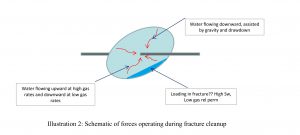Investigation Of Liquid Loading Mechanism Within Hydraulic Fractures In Unconventional / Tight Gas Reservoirs And Its Impact On Productivity
本文主要研究了在非常规或致密气藏中,压裂裂缝内液体积聚(液体加载)的机制及其对气井生产力的影响。研究发现,在低渗透率/致密/非常规气藏的压裂过程中,由于液体(压裂液)在裂缝内积聚,导致气井的生产力和压裂液回收率受到严重影响。通过3D数值模拟,考虑了重力和毛细管压力的影响,研究了不同条件下液体加载对气井生产力的影响。结果表明,低抽吸压力、低基岩渗透率或低初始气流量会加剧裂缝内的液体加载问题,从而影响初期生产期间的清理和气体生产力。研究还探讨了在含凝析油的非常规气藏中,液体加载现象对气井生产力的影响,以及速度依赖相对渗透率和水蒸发效应(通过组成模拟)的作用。这些发现有助于选择最优的生产设施和井筒配置,以提高气井的生产力和压裂液回收率。
CMG软件的应用情况
在本研究中,CMG软件的两个模块——IMEX和GEM被用于模拟和分析压裂裂缝内的液体流动和回收过程。IMEX模块用于黑油模型的模拟,而GEM模块则用于组成模型的模拟,包括干燥气和湿气系统。这些模拟考虑了速度依赖相对渗透率和水蒸发模型,以更准确地预测液体在裂缝内的行为和对气井生产力的影响。通过这些模拟,研究者能够评估不同操作条件和地质参数对液体加载和气井性能的影响,为实际的气井开发和管理提供了重要的理论依据。
中文作者单位
Samarth Agrawal 德克萨斯大学奥斯汀分校,该研究得到了德克萨斯大学奥斯汀分校的 hydraulic fracturing and sand control联合工业项目(JIP)的持续技术支持和财政资助。
Abtract
One of the major challenges in fracturing low permeability/tight/unconventional gas formations is the loss of frac water and well productivity due to fluid entrapment in the matrix or fracture. Field results have indicated that only 15-30% of the frac fluid is recovered at the surface after flow back is initiated. Past studies have suggested that this water is trapped in the rock matrix near the fracture face and remains trapped due to the high capillary pressure in the matrix. Significant efforts have been made in the past to understand the impact of liquid blocking in hydraulically fractured conventional gas wells. Numerous remediation measures such as huff and puff gas cycling, alcohol or surfactant based chemical treatments have been proposed to reduce fracture face damage. However, when considering hydraulic fractures in unconventional reservoirs horizontal wells, the fluid may also be trapped within the fracture itself and may impact the cleanup as well as productivity. This study shows that under typical gas flow rates in tight / shale gas formations, liquid loading within the fractures is likely to occur. Most of the previous simulation studies consider a 2D reservoir model and ignore gravity, considering the high vertical anisotropy (or extremely low vertical permeability) in these tight reservoirs matrix. However, this study presents the results of 3D simulations of liquid loading in hydraulic fractures in horizontal wells, including gravity and capillary pressure effects. Both CMG IMEX and GEM have been used to study this phenomenon in dry and wet gas cases. The impact of drawdown, fracture and reservoir properties on liquid loading and well productivity is presented. Results show that low drawdown, low matrix permeability or low initial gas rates aggravate the liquid loading problem inside the fracture and thereby impact the cleanup and gas productivity during initial production. A clear understanding of the phenomena could help in selection of optimal production facilities and well profile.



